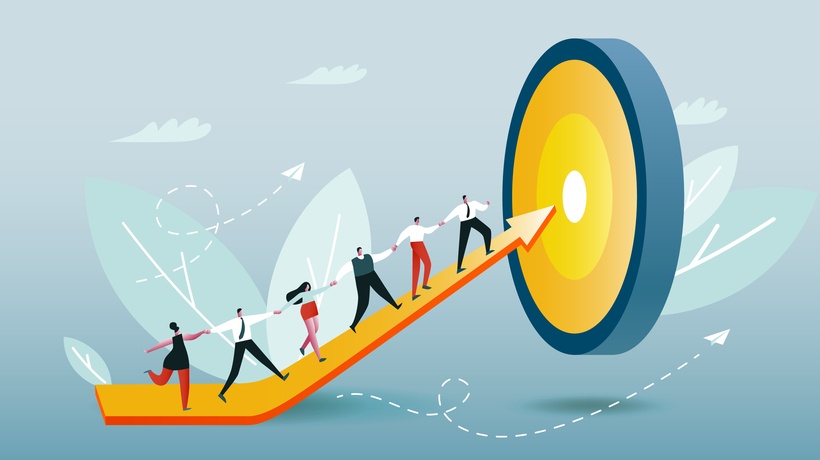The Ladder Of Capability: Maintain A Capability Advantage
Capability underpins organizational torque. Knowledge is mostly ubiquitous, given the World Wide Web and the smart search engines that readily access the required information. So, what are the processes necessary to build and maintain the capability advantage that underpins organizational torque?
One means of building a capability advantage is by hiring the right talent. This is obviously important. However, it is not enough for two reasons. Firstly, talented people are transient, they come and go. Secondly, given rapid change, the knowledge and skills that you hire someone for today may be redundant tomorrow.
The processes behind any worthy Learning Management System (LMS) must supply solutions to ensure it meets the organizational challenges of transient talent and of staying relevant in times of change. The "ladder of capability" illustrates the sequence of steps required to build and maintain a capability advantage for any organization. It is a simple illustration that can be used to facilitate rich discussions between managers and their teams to develop communal ownership of the organization's LMS and an understanding of how to continually nurture and evolve it.
The Challenge Of Transient Talent
Gone are the days when leaders could see their organizations as closed systems for which they could buy talent and “contain it,” by using various retention strategies.
In fact, we need to adjust our thinking by redefining organizations as open-ended communities of people, formally assembled, for a common purpose. Talented people join and leave organizations much more rapidly than ever before. The challenge then is not about how to retain talent, but rather how to get talented people to create a legacy of their talent and vest it in the organization.
Learning Management Systems should provide the means to enable talented people to weave a legacy of their talent and skill into the fabric of the organization. This then forms part of the corporate DNA that provides the organizational torque required to compete with tough opposition and power through difficult and challenging times.
It is human nature to want to leave a legacy. Organizations need to create the means and make it worthwhile for employees to do so. Interestingly, when people invest their talent in an organization, it increases their sense of belonging and commitment. They are more likely to stay longer and when they do move on, they will continue to have a vested interest in the organization, which has obvious benefits.
The Challenge Of Staying Relevant In Times Of Rapid Change
Reputable LMSs are technically sound and smart. It goes without saying that institutionalized, up-to-date, capacity and capability solutions should be readily available to support employees with exactly the help they need, in the format they need, when they need it, on the go, and without leaving the workflow.
However, an LMS is only as valuable as its content. How relevant and up-to-date is your LMS content? How sound and smart are the processes that keep the curated content of your organizational capacity and capability up to date and relevant?
Scaling The Ladder Of Capability To Secure A Capability Advantage
Use the "ladder of capability" to facilitate discussions to improve LMS User Experience and promote a mindset of thinking about tasks, versus performing them rote. Encourage employees to make suggestions on better or different ways of doing things and incorporate these into the LMS. This paves the way for User-Generated Content (UGC) which creates a sense of ownership and thereby, increases commitment to the LMS. These are essential ingredients for using an LMS to leverage an ongoing capability advantage to deliver organizational torque.
Managers and Subject Matter Experts (SME) must be able to nimbly move up and down the "ladder of capability" as required to ensure that the content of their LMS remains up-to-date, relevant and fully functional.
The "ladder of capability" illustrates the sequence of value-add required to build and maintain the capability advantage that resides in an LMS. Starting at the bottom, the capability value-add increases with each successive rung, as follows:
- Understand it
Be able to clearly explain it - Demonstrate or do it
At whatever level is required in that job - Instruct it
Explain it and teach others to do it - Manage others doing it
In addition to the previous 3 steps, this involves guidance, feedback, and corrective action - Codify it
Systemize or institutionalize it by way of tools, methods, and processes - Lead it
Visualize and scan the future, so as to be able to change/adapt/evolve capability to remain relevant
As the "ladder" is climbed, contribution reaches beyond one’s own current contribution to benefit the contribution of others, immediately and in the future. Recognition and reward systems must reinforce this value-add so that it iterates.
Beware of introducing new capabilities without thinking them through carefully. Sometimes organizations simply “plug in” a new system or process and wonder why it fails? This is where the "ladder of capability" informs discipline.
The "ladder of capability" suggests a discipline of taking any new thinking down to the bottom rung of the ladder and ensuring that the following questions are answered:
- Do we understand how this new thinking differs from how we currently think? And, does it make sense?
- How will it change the way that we currently do things? What are the knock-on effects?
- How will it change the way we instruct it? How will we need to teach it differently?
- What are the implications for managing it?
- How do we codify it? How do we interface it seamlessly with other related systems and processes? Have we tested it to ensure that there are no undesirable effects? Have we adapted other interrelated systems and processes accordingly?
- How do we lead the required changes? What mindset changes are needed and how will we achieve this?
The "ladder of capability" is a useful tool to support the understanding of the curation process of your LMS. Use it with due diligence to ensure your LMS leverages talent by using technology to deliver the torque that your organization requires to succeed today, tomorrow and in the future.









